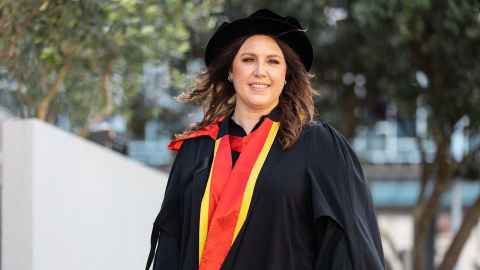Taking a scientific approach to dance
29 September 2022
We need to take a more scientific approach to understanding the health benefits of dance, says Carlene Newall de Jesus, who did so for her PhD.

When researchers talk about the cognitive benefits of dance, what type of dance and what aspect of dance are they talking about?
This was the question Carlene’s Newall de Jesus posed to herself for her PhD with which she graduated this week, in which she bought together the two disciplines in which she has studied, dance and psychology.
Carlene is a lecturer in Dance Studies at the University and has had an extensive career as a choreographer, dance filmmaker, and has created work for stage and a range of television and film projects. Her list of many awards includes a University of Auckland Cultural Blue's Award for filmmaking in 2021, and a Cultural Blue’s Award for circus and dance in 2011.
Carlene entered the dance world as both a dancer and circus practitioner, having trained as an aerial artist as a teenager after a flying trapeze school moved into her neighbourhood. She is currently artistic director of HighJinx Youth Company, Aotearoa's leading circus youth company. “But I’ve definitely retired from circus performing after one too many broken bones,” she says, adding drily: “Things that are high tend to have an element of risk.”
Carlene studied her PhD through the Dance Studies programme as well as the Centre for Brain Research (CBR) at the University, supported with funding from the Freemason Foundation. She had initially intended to investigate the benefits of dance on cognitive health by introducing it as a health intervention among older people, to assess whether it would prevent or inhibit the progress of dementia.
It quickly became apparent that much of the research that had been done in the area was limited by the ways in which dance could be measured, described and replicated – or more accurately, hadn’t been.
If we want to say ‘dance has this benefit on cognition for older adults’ that’s like saying a meal is good for health. You wouldn’t say that. You would talk about the ingredients that make up a meal ... we should apply the same empirical expectations to dance.
We need to take a more scientific approach to understanding the health benefits of dance, she says, and having degrees in dance and psychology, and as well as a Master of Science in health psychology, she saw her doctoral research as a chance to combine both disciplines.
“A lot of researchers were looking at dance and cognitive health, but the research described dance in a way that often gave little information about what happened. It might say, for instance, ‘ten minutes of ballroom dancing was carried out’. The question immediately is what happened in the dance class? Was the class about teaching people to get all the movements right? Were people remembering and dancing a dance they learned 50 years ago? Or were they learning a new way to move their body?
“Dance is made up of all these different components that make up this activity that we call dance."
She shifted her focus to firstly, identifying and describing the key elements involved in dance classes for older adults. She then developed an observational tool that would allow those leading or researching dance to be able to describe in detail, what was happening at any given moment in a dance session. In the long run she hopes it will contribute to further research of dance as a health intervention, and an understanding of how it could benefit and be prescribed for older populations, in a scientific way – in a measurable way, in a way that could be replicated.
It may be that one of the crucial benefits of dance is the social aspect, of bringing people together. If so that needs to be understood by anyone leading a dance session aimed at improving cognitive health.
“If you put people in a room together, socialisation just doesn't automatically happen. If socialisation is the key thing that's having an impact on cognitive health, you want to see that people are interacting with each other and doing things together.”
Throughout her thesis, she drew the analogy between the elements of dance and the elements of a good meal.
“If we want to say ‘dance has this benefit on cognition for older adults’ that’s like saying a meal is good for health. You wouldn’t say that. You would talk about the ingredients that make up a meal, and any recommendations of what should be in a meal would be informed by an evidence-based understanding of the nutritional content of the meal. We should apply the same empirical expectations to dance.
“Dance is sometimes thought of as this this kind of magical ‘other’ thing that just happens, and maybe if we look too closely at it, the magic could disappear.
“But dance is such a human thing to do, and it's ingrained in so many parts of people's lives that if we want to know how to use it in health contexts, we should be willing to look at it through a scientific lens and look at it closely. Not see it is this kind of untouchable creative thing.
“As researchers we need to understand dance in the same way that that research would try and understand pharmaceutical interventions or dietary interventions. There’s an awareness in scientific research that the details of those things matter, and similarly, the details of dance matter.”
Media contact
Margo White I Media adviser
Mob 021 926 408
Email margo.white@auckland.ac.nz